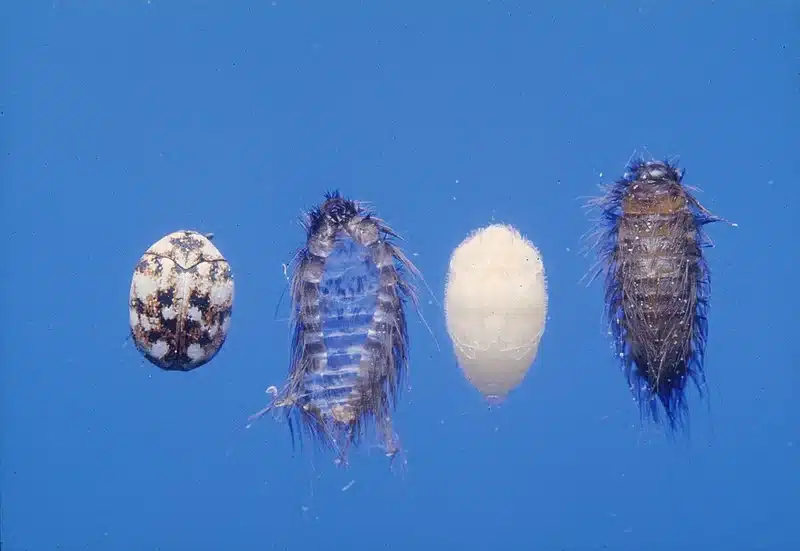Finding tiny, hairy bugs in your closet or noticing mysterious holes in your wool sweater? You might be dealing with carpet beetle larvae. After four years as a registered technician and working with our family business that’s served the DMV area for over 50 years, I’ve seen countless carpet beetle problems in area homes.
These destructive pests can quietly damage your most valuable fabrics while hiding in the darkest corners of your home. The good news is that once you know what to look for and how they behave, you can eliminate them effectively.
In this guide, I’ll show you exactly how to identify carpet beetle larvae, understand why they’re causing damage, and eliminate them using proven methods that work in our Mid-Atlantic climate.
What Are Carpet Beetle Larvae?
Carpet beetle larvae are the destructive stage of small beetles that belong to the family Dermestidae. Here in the DMV area, we commonly encounter three main species that cause problems in homes.
The varied carpet beetle (Anthrenus verbasci) produces tiny, teardrop-shaped larvae that are 4-5 mm long with banded brown hairs. The black carpet beetle (Attagenus unicolor) creates larger “carrot-shaped” larvae that can reach half an inch with golden-brown coloring and a single tail tuft. Additionally, the furniture carpet beetle (Anthrenus flavipes) appears similar to the varied species but with more yellow coloring.
These beetles undergo complete metamorphosis, progressing from egg to larva to pupa to adult. The larval stage is when all the fabric damage occurs, which is why understanding this life stage is so important for homeowners. For more detailed information about beetle development, check out our guide on Understanding Beetle Larva: Development and Identification.
Appearance: Hairy, Bristly, Carrot-Shaped, Brown with Banded Patterns
Carpet beetle larvae have a very distinctive appearance that sets them apart from other household pests. They have elongated, cigar or teardrop-shaped bodies that are covered in dense, bristly hairs called setae.
These larvae display brown coloring with alternating light and dark bands running across their bodies. The varied carpet beetle larvae appear broader in the middle, while black carpet beetle larvae taper toward a distinctive tufted tail. Under a 10x hand lens, the bristly texture becomes very apparent.
Size varies depending on the species and developmental stage. Varied carpet beetle larvae typically reach 3mm at their final stage, while black carpet beetle larvae can grow up to 10mm. One of the most reliable signs of their presence is finding cast skins (exuviae) that look like hollow, straw-colored versions of the larvae themselves.
Carpet Beetle Larvae vs. Adult Beetles: Key Differences
Many homeowners get confused about which stage actually causes damage. The truth is that adult carpet beetles and carpet beetle larvae have completely different behaviors and feeding habits.
Adult beetles are small, oval, hard-bodied insects with wings. They’re attracted to light and primarily feed on pollen and nectar outdoors. When you find them inside, they’re usually just looking for a way back outside. Adults typically live only a few weeks and rarely cause any damage.
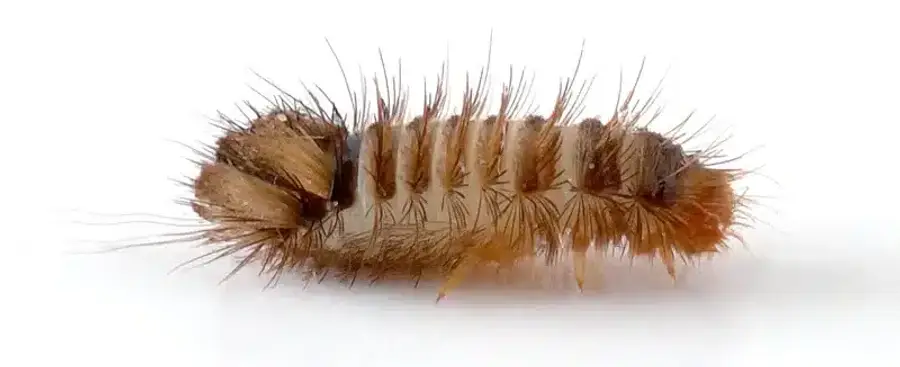
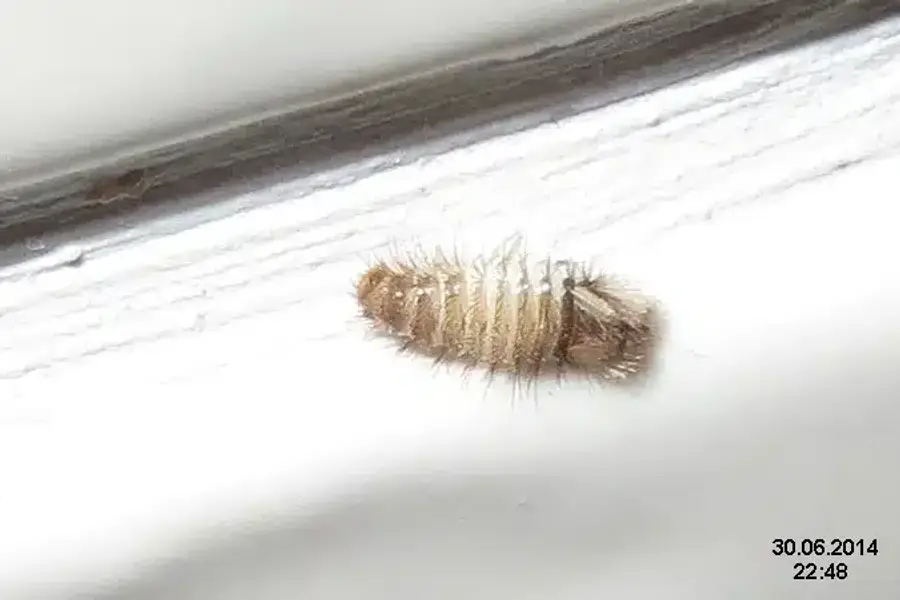
Carpet beetle larvae, on the other hand, are wingless, hairy, and actively avoid light. They spend months or even years feeding on protein-rich materials in your home. This extended larval period is when all the fabric damage occurs. For more information about carpet beetle biology and behavior, visit our article on Are Carpet Beetles Dangerous? What You Need to Know.
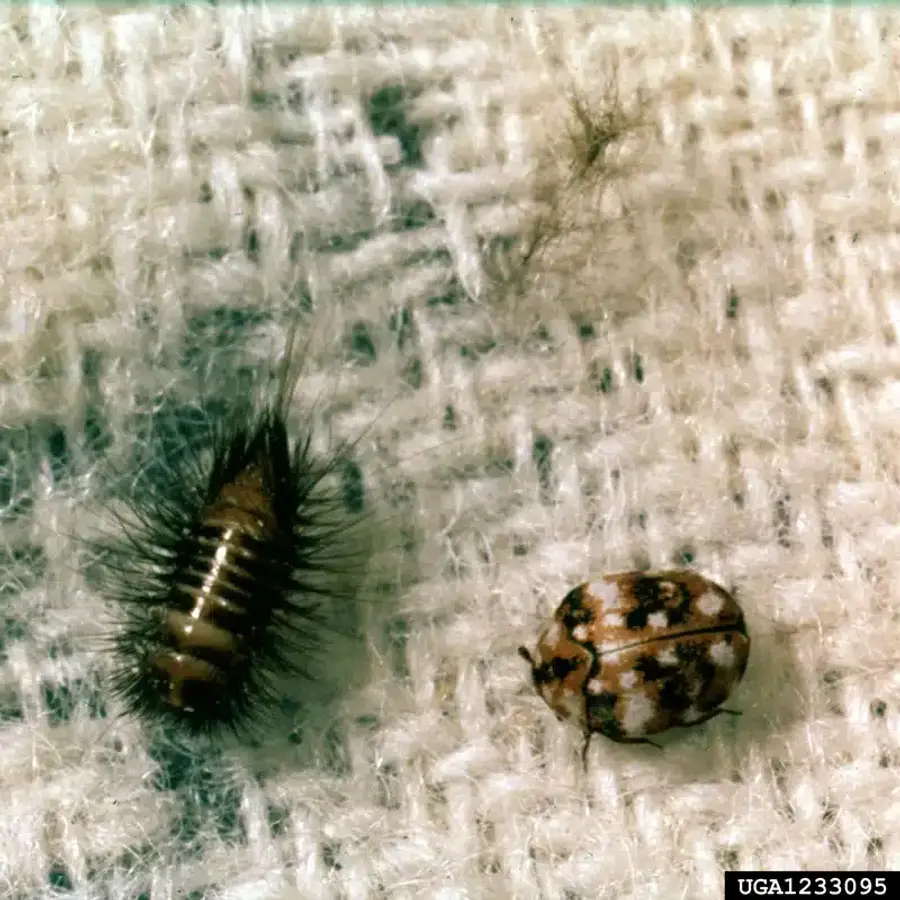
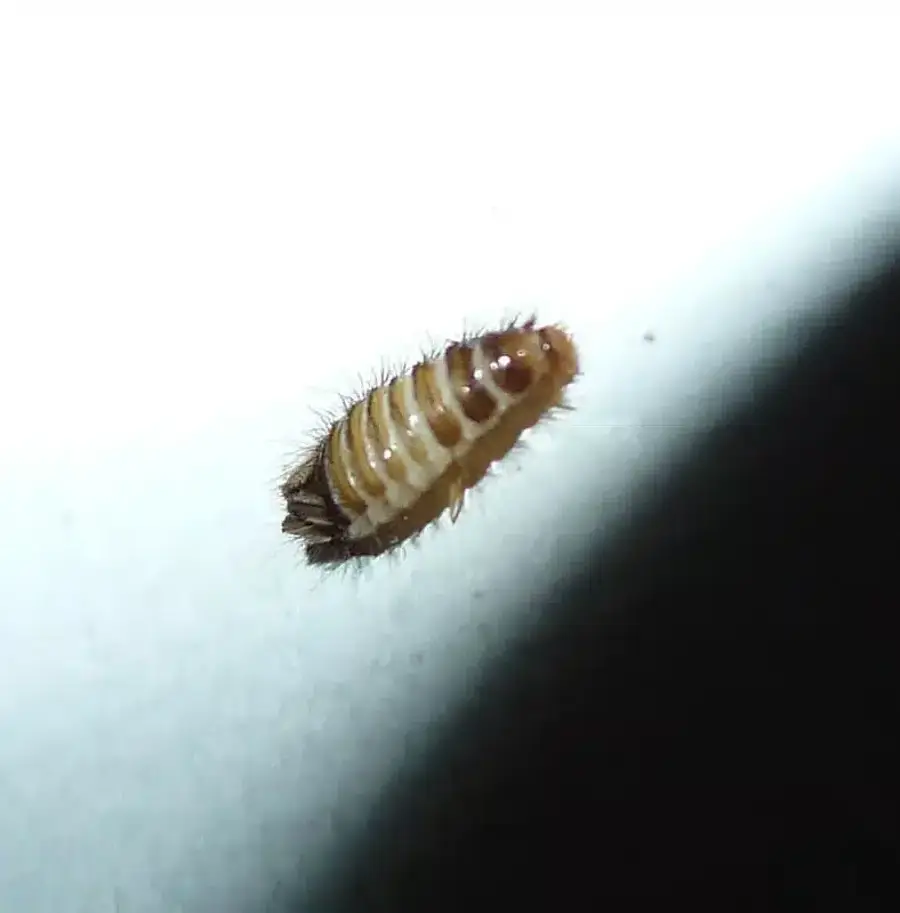
Why Carpet Beetle Larvae Cause Fabric Damage (Adults Don’t)
The reason carpet beetle larvae cause damage while adults don’t comes down to their biology and feeding equipment. Larvae possess robust mandibles (chewing mouthparts) and special digestive enzymes that can break down keratin, chitin, and casein - the proteins found in animal fibers.
Adult beetles have poorly developed mouthparts that aren’t designed for chewing tough materials like wool or silk. Instead, they’re adapted for feeding on pollen and nectar when they’re active outdoors. Even when adults find their way indoors, they typically don’t feed at all.
This biological difference explains why you might see adult beetles around windows in spring and summer but find fabric damage months later when the larvae they produced are actively feeding. Understanding this timing helps homeowners focus their control efforts on the right life stage.
Feeding Preferences: Wool, Silk, Feathers & More
Carpet beetle larvae have specific preferences when it comes to food sources. They primarily target natural animal fibers that contain keratin and other proteins they can digest.
Their favorite foods include:
- Wool clothing and blankets
- Silk garments and furnishings
- Felt materials
- Feathers in pillows or decorations
- Leather goods and fur
- Pet hair and natural-bristle brushes
Additionally, they’ll feed on secondary sources when primary foods aren’t available. This includes synthetic fabrics soiled with sweat or food, grain-based rodent baits, dead insects in light fixtures, and even bird or wasp nests in attics. The University of Maryland Extension confirms that these feeding preferences make carpet beetles particularly problematic for homes with natural fiber furnishings.
Common Hiding Spots: Closets, Furniture & Baseboards
Carpet beetle larvae prefer dark, undisturbed areas where they can feed without interruption. In my experience servicing homes across the DMV area, I consistently find them in predictable locations.
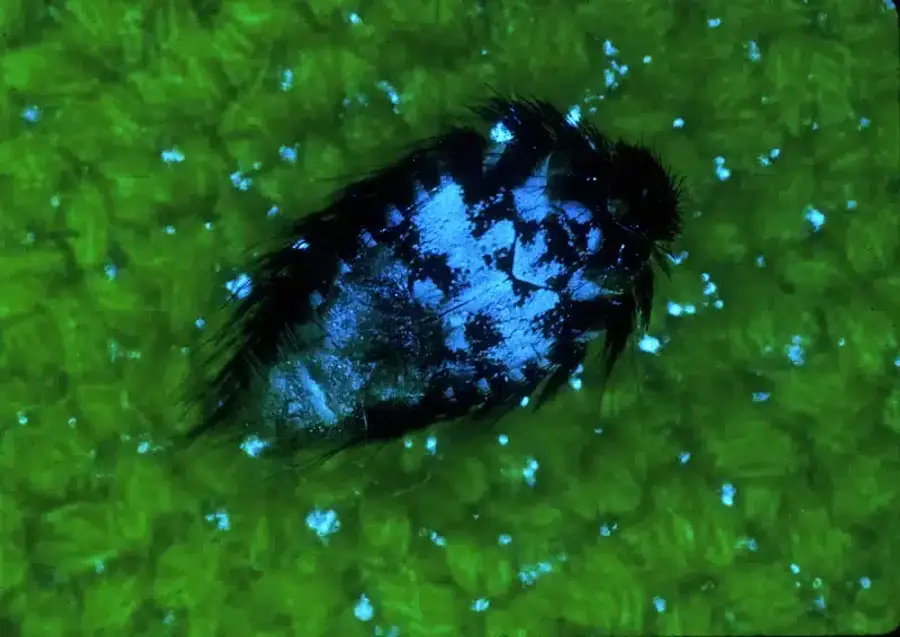
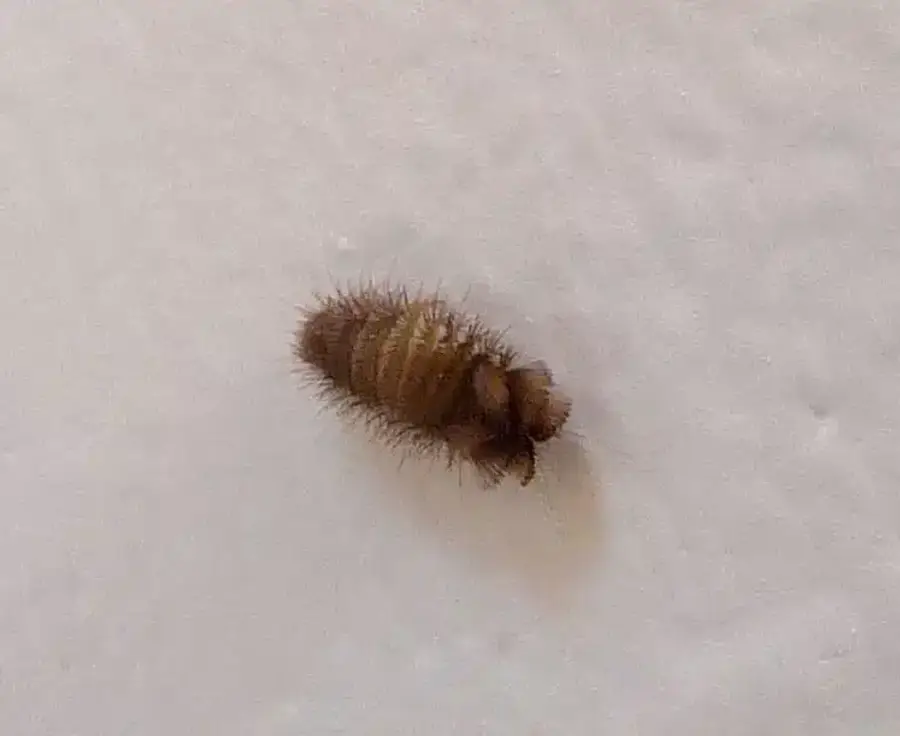
Closets are prime real estate for these pests, especially where wool suits and blankets are stored long-term. They also love hiding under heavy furniture and along baseboards where lint and pet hair accumulate. Air ducts and cold-air returns provide perfect highways between rooms.
Storage areas like attics, spare rooms, and trunks create ideal conditions because they’re rarely disturbed. I’ve also found significant populations at the edge of wall-to-wall carpet where the pad interface creates a perfect hiding spot. Even felt inside pianos or pool tables can harbor large populations.
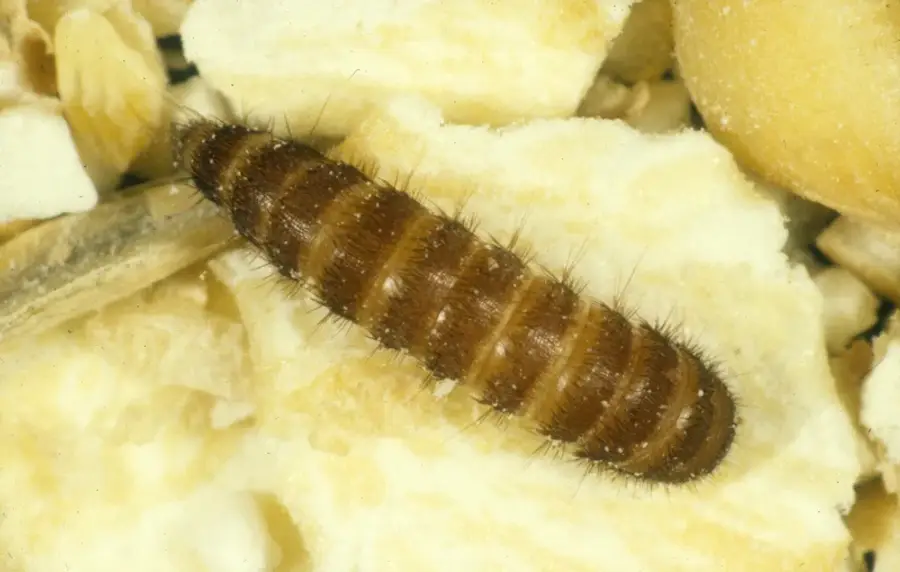
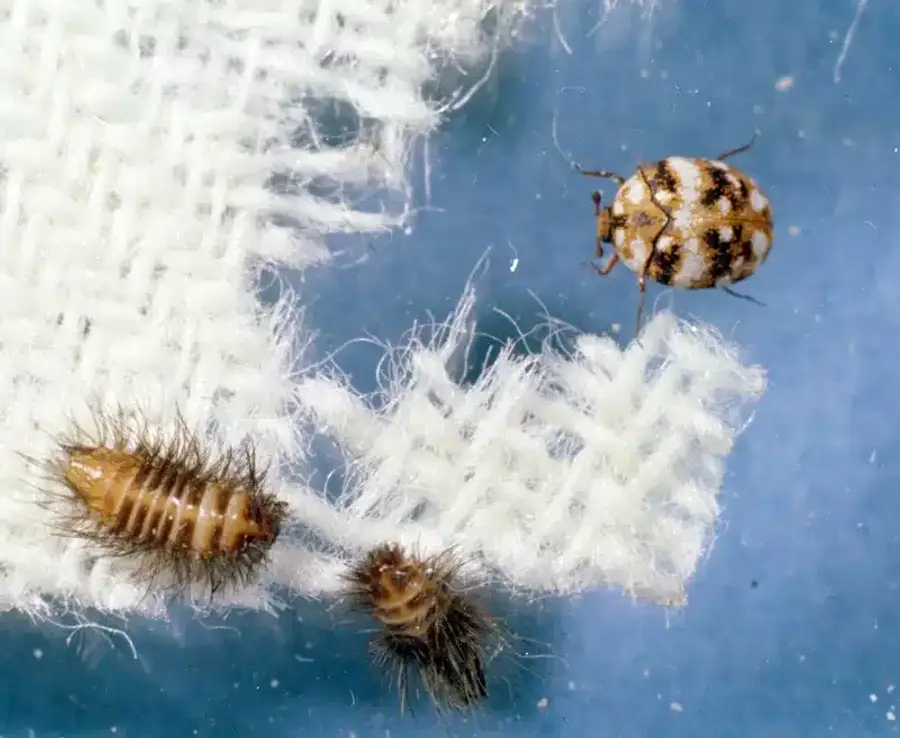
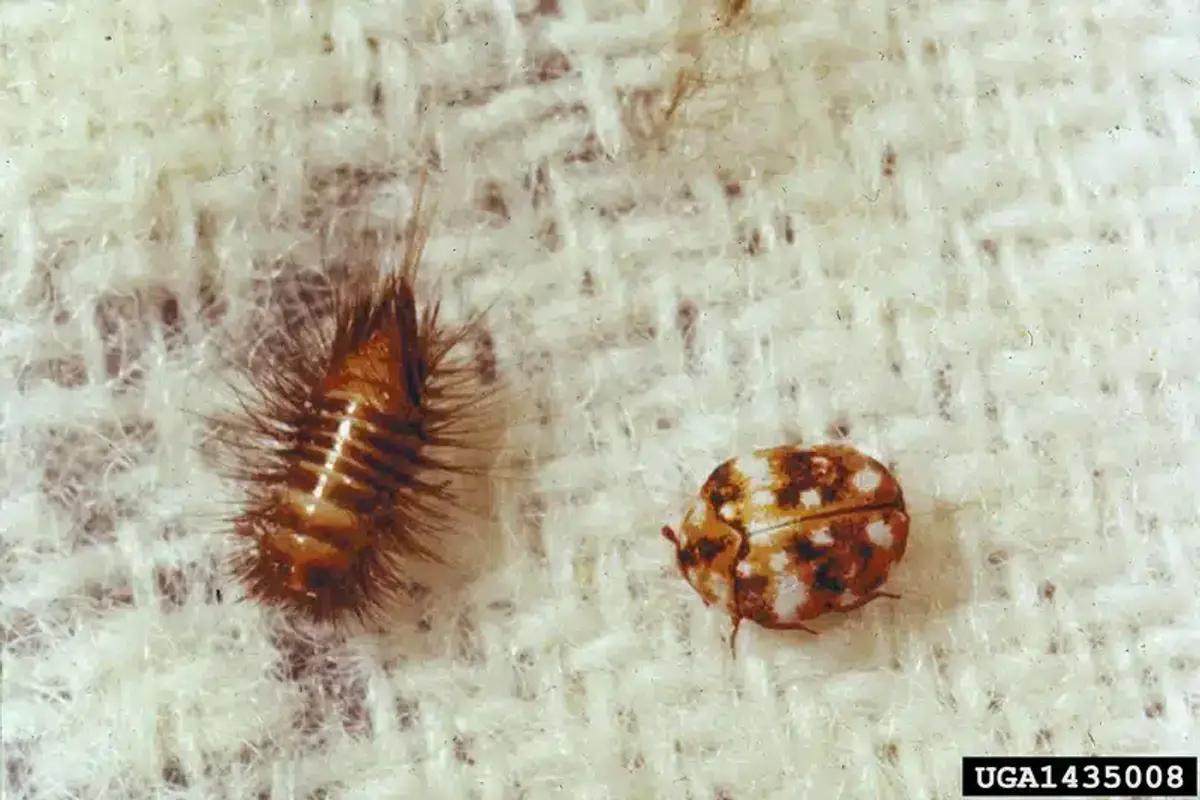
Signs of Carpet Beetle Infestation: Irregular Holes, Frass & Shed Skins
Recognizing the signs of carpet beetle larvae activity helps you catch infestations early before major damage occurs. Unlike moths that leave clean-cut holes, carpet beetle damage appears as irregular, scattered holes with loose edges where threads have been pulled rather than cut.
The larvae prefer to feed in hidden areas of garments like under collars and inside folds. On carpets, you’ll notice a “grazed” appearance along the nap. Look for sand-grain-sized dry frass (waste) mixed with loose fibers around damaged areas.
Cast skins are one of the most reliable indicators of carpet beetle larvae presence. These hollow, straw-colored shells look exactly like the larvae but are translucent. For a comprehensive guide to identifying these and other signs, check out Signs of Carpet Beetles: How to Spot an Infestation.
Life Cycle & Timing in Heated vs. Unheated Structures
Understanding the carpet beetle larvae life cycle helps you time your control efforts effectively. The complete metamorphosis includes egg, larva, pupa, and adult stages with timing that varies significantly based on temperature and humidity.
Eggs hatch in 6-15 days at room temperature. The larval period ranges dramatically from 60 days under ideal conditions (24°C and 70% humidity) to over 650 days in cool, unheated closets. Pupation occurs inside the last larval skin and takes 6-24 days.
In the Mid-Atlantic region, adults typically emerge from March through September. However, in heated homes, all life stages can be present year-round. Most species complete one generation per year, though smaller species may produce 3-4 generations in warm indoor environments. The Ohio State extension notes that this timing variation makes year-round vigilance important for homeowners.
Health & Allergy Considerations: Irritating Larval Hairs
Carpet beetle larvae can cause health issues beyond just fabric damage. The detached larval hairs, called hastisetae, may trigger contact dermatitis, rhinitis, or asthma-like symptoms in sensitive individuals.
These reactions often appear as a papular rash that resembles scattered mosquito bites. However, this is an allergic response to the hairs, not actual insect bites. Some people also experience respiratory symptoms when large numbers of larvae and shed skins accumulate in living areas.
If household members develop unexplained skin reactions or respiratory issues alongside fabric damage, carpet beetle larvae could be the culprit. The CDC has documented cases where these allergic reactions were initially misdiagnosed because the connection to carpet beetles wasn’t recognized.
Monitoring & Early Detection Methods
Early detection of carpet beetle larvae saves both fabrics and money. I recommend several monitoring techniques that work well for homeowners in our area.
Start by inspecting your vacuum bag or canister contents for larvae and cast skins after cleaning closets and carpet edges. Use a flashlight to examine carpet edges, under furniture skirts, and along baseboards where lint accumulates.
Sticky blunder traps placed near closets effectively catch wandering carpet beetle larvae. Additionally, finding adult beetles on window sills during spring and summer signals that hidden larval populations are likely present nearby. For more detailed information about identifying potential bite symptoms, visit Carpet Beetle Bites: How to Know What’s Biting You.
How to Get Rid of Carpet Beetles: Integrated Elimination Tactics
Successfully eliminating carpet beetle larvae requires a comprehensive approach that targets all life stages and addresses the conditions that support them. Based on my experience treating infestations across the DMV area, here’s what actually works.
Deep Vacuuming Strategy
Thorough vacuuming forms the foundation of any successful carpet beetle larvae elimination program. Focus your efforts on carpet edges, padding seams, and upholstery channels where larvae hide and feed.
Pay special attention to areas under heavy furniture and along baseboards where lint accumulates. Vacuum inside closets, paying close attention to corners and along the carpet-wall interface. Always empty your vacuum canister or bag outdoors immediately after cleaning to prevent re-infestation from any live larvae you’ve collected.
Hot Water Laundering, Heat Treatment & Freezing
Heat and cold treatments effectively kill carpet beetle larvae in washable items. Wash infested fabrics in water at 130°F (54°C) or higher for at least 30 minutes, or run them through a hot-dry cycle.
For delicate or dry-clean-only items, freezing works well as an alternative. Double-bag items and freeze them at 0°F (-18°C) for 48 hours. This achieves over 95% larval mortality without damaging sensitive fabrics. Many professional conservators use this method for valuable textiles.
Proper Storage Methods & Exclusion
Preventing carpet beetle larvae access to food sources breaks their life cycle effectively. Store only clean garments, as even small amounts of food or sweat residue can attract larvae.
Use airtight bins or vacuum-sealed bags for long-term storage. Cedar-lined chests provide some protection but aren’t foolproof - refresh cedar oil regularly or combine with other methods for better results. Regular garment rotation every six months disrupts any developing infestations.
Natural Deterrents: Cedar, Essential Oils & Diatomaceous Earth
Several natural products help deter carpet beetle larvae without harsh chemicals. Cedar volatiles like cedrol and thujaplicin reduce adult survival and egg hatch rates, though they don’t provide 100% protection.
Essential oils including lavender and peppermint offer short-term repellency when applied to storage areas. Food-grade diatomaceous earth or boric acid dust applied in wall voids mechanically damages larvae that crawl through it. Research shows cedar can be effective when used consistently and refreshed regularly.
When to Discard Heavily Damaged Items
Sometimes disposal becomes the most practical option for heavily infested items. If holes exceed 20-30% of the fabric surface area, or if the item has low sentimental or monetary value, disposing of it removes both the food source and any carpet beetle larvae it contains.
Seal discarded items in trash bags before disposal to prevent spreading the infestation. This same threshold is used by museum conservators when deciding whether textile restoration is worthwhile.
Engaging a Professional for Severe Infestations
Professional treatment becomes necessary when carpet beetle larvae populations spread to structural voids, when infestations recur despite thorough DIY efforts, or when residents experience allergic reactions to larval hairs.
Licensed technicians can apply residual treatments or silica aerogel dust in cracks and wall voids where homeowners can’t safely reach. Professional treatments focus on targeted spot applications rather than broadcast spraying, following modern integrated pest management principles.
For information about professional pest control costs, check out our guides on Exterminator Cost: What You’ll Pay for Pest Control Services and How Much Does Pest Control Cost? 2025 Service Price Guide.
Long-Term Prevention for Mid-Atlantic Homeowners
Preventing future carpet beetle larvae infestations requires understanding adult beetle behavior and seasonal timing in our region. Adults fly to lights during their peak activity period from April through June, coinciding with dogwood and Spiraea blooms.
Install tight-fitting screens on windows before this peak flight period. Seal baseboard gaps and caulk around floor registers since forced-air ducts accumulate the lint that attracts larvae. Inspect cut flowers and remove any bird nests before bringing them indoors.
Schedule biannual closet cleaning in mid-summer and late winter to align with local beetle biology. This timing helps catch any developing infestations before they cause significant damage. Regular inspection and cleaning remain your best defense against these persistent pests.
Frequently Asked Questions
What do carpet beetle larvae look like?
+
Carpet beetle larvae are small, hairy, carrot-shaped insects that range from 3-10mm long depending on the species. They have brown coloring with alternating light and dark bands across their bristly bodies. The larvae avoid light and move slowly when disturbed, often curling up when touched.
How can I tell the difference between carpet beetle larvae and adults?
+
The key differences are dramatic. Carpet beetle larvae are wingless, hairy, and feed on fabrics while avoiding light. Adults are small, round, winged beetles that feed on pollen outdoors and are attracted to light. Only the larvae cause fabric damage.
What causes the irregular holes in my wool garments?
+
Carpet beetle larvae create irregular holes with loose, frayed edges because their mandibles pull and chew protein fibers rather than cutting them cleanly. They also leave behind sand-grain-sized frass mixed with loose fibers around the damaged areas.
Can essential oils really repel carpet beetle larvae?
+
Essential oils like cedar, lavender, and peppermint provide short-term repellency against carpet beetle larvae but aren't completely reliable. They work best as part of an integrated approach that includes proper storage, regular cleaning, and exclusion methods.
How do I prevent carpet beetle larvae in my closet?
+
Store only clean items in airtight containers or vacuum-sealed bags. Refresh cedar oil regularly if using cedar storage, and rotate garments every six months. Regular vacuuming of closet floors and corners removes the lint and pet hair that attracts larvae.
When should I call a professional pest control service?
+
Contact a professional when carpet beetle larvae infestations persist after thorough DIY efforts, when populations spread to wall voids or structural areas you can't access, or when household members develop allergic reactions to the larval hairs.
Are carpet beetles and their larvae active year-round?
+
In heated homes, carpet beetle larvae can develop year-round, though they grow more slowly in cooler conditions. Adults typically emerge from March through September in the Mid-Atlantic region, but indoor populations may not follow seasonal patterns.
How long does it take to eliminate a carpet beetle larvae infestation?
+
Elimination timeframes vary based on infestation severity, but expect 2-3 months minimum for thorough treatment. Carpet beetle larvae can live for months or years, so follow-up treatments and monitoring are essential to ensure complete elimination.
With five years of hands-on experience in the pest control industry, George Schulz is a registered technician with the Virginia Pest Management Association and a proud third-generation professional in a family business that's been protecting homes for over 57 years. He manages and trains a team of service pros while also leading internal research efforts—recently spearheading a deep-dive review of thousands of documents on pest control materials to hand-pick the most kid and pet friendly, most effective solutions tailored specifically for homes in the DC metro area.
